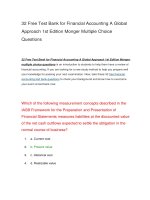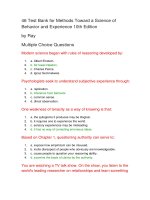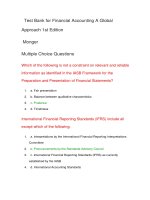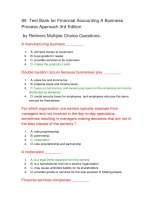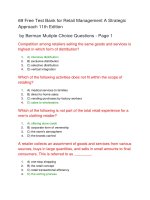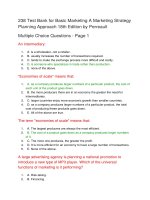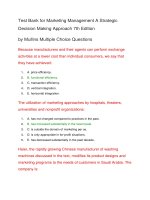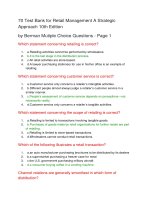46 test bank for methods toward a science of behavior and experience 10th edition
Bạn đang xem bản rút gọn của tài liệu. Xem và tải ngay bản đầy đủ của tài liệu tại đây (30.4 KB, 8 trang )
46 Test Bank for Methods Toward a Science of
Behavior and Experience 10th Edition
by Ray
Multiple Choice Questions
Modern science began with rules of reasoning developed by:
1.
2.
3.
4.
a. Albert Einstein.
b. Sir Isaac Newton.
c. Charles Peirce.
d. Ignaz Semmelweis.
Psychologists seek to understand subjective experience through:
1.
2.
3.
4.
a. replication.
b. inference from behavior.
c. common sense.
d. direct observation.
One weakness of tenacity as a way of knowing is that:
1.
2.
3.
4.
a. the syllogisms it produces may be illogical.
b. it requires one to experience the world.
c. sensory experiences may be misleading.
d. it has no way of correcting erroneous ideas.
Based on Chapter 1, questioning authority can serve to:
1.
2.
3.
4.
a. expose how empiricism can be misused.
b. incite disrespect of people who obviously are knowledgeable.
c. cause people to question your reasoning ability.
d. examine the basis of claims by the authority.
You are watching a TV talk show. On the show, you listen to the
world's leading researcher on relationships and learn something
that might improve your relationships. Your new knowledge was
acquired through:
1.
2.
3.
4.
a. authority.
b. common sense.
c. tenacity.
d. reason.
In contrast to tenacity, authority, and reason, common sense is an
improvement because it:
1.
a. automatically checks our assumptions.
2.
3.
4.
b. appeals to direct experience.
c. represents the accumulation of scientific knowledge.
d. is based on blindsight.
Science is based on the notion that to discover the world, one
must:
1.
2.
3.
4.
a. develop ideas of how the world operates.
b. experience it.
c. reason how the world ought to be.
d. discover through philosophy the functions of the world.
The case of Semmelweis is important because it illustrates:
1.
2.
3.
4.
a. the importance of ruling out factors.
b. a longitudinal design.
c. the necessity of debriefing.
d. how bias can influence the outcome of a study.
You are studying anxiety. Which of the following can you not
directly observe?
1.
2.
3.
4.
a. heart rate
b. nervousness
c. sweaty palms
d. self-report of anxiety
Compared to researchers in other sciences, psychologists have
consisted of a:
1.
2.
3.
4.
a. larger percentage of women.
b. smaller percentage of women.
c. larger percentage of minorities.
d. larger percentage of minorities.
We can gain new knowledge through reason and logic, but the
accuracy of our conclusions is dependent upon:
1.
2.
3.
4.
a. the laws of probability.
b. our own experiences.
c. the accuracy of our assumptions.
d. parsimony.
Which of the following is not a subjective experience?
1.
2.
3.
4.
a. shaking because of nervousness
b. confusion
c. severe anger
d. sadness
____ has a self-corrective mechanism.
1.
2.
3.
4.
a. Tenacity
b. Authority
c. Science
d. Reason
Newton's rule for developing explanations that are true, sufficient,
and simple best illustrates:
1.
2.
3.
4.
a. the law of parsimony.
b. empiricism.
c. order in nature.
d. tenacity.
To ensure that an experimental finding is not just a fluke, a
scientist should:
1.
2.
3.
4.
a. base conclusions on personal experience.
b. use logical inference.
c. operationalize the experiment.
d. replicate the experiment.
Which of the following is not one of the four possible ways of
studying psychological processes, according to Schumacher?
1.
2.
3.
4.
a. studying our own personal world
b. studying the personal world of others
c. studying our outward behavior that others can observe
d. studying our spirit
A famous athlete appears on a television infomercial and claims
that a new device to alleviate aches and pains has been
extremely effective for her. Because no published, peer-reviewed
studies have supported the effectiveness of the device, this may
be an example of:
1.
2.
3.
4.
a. superstition
b. empiricism
c. science
d. pseudoscience
Much to his credit, the story of King Croesus illustrates the
importance of:
1.
2.
3.
4.
a. calculating probability in determining truth.
b. carefully defining variables.
c. considering multiple causes of a phenomenon.
d. testing in determining truth.
Dr. Simon is discussing the role of inference in research. She
says that psychologists study the outside to know about the
inside. Is she correct?
1.
2.
3.
4.
5.
a. No - she has it backwards; we study the inside to know about the
outside.
b. No - inference does not play a role in research.
c. Yes - we infer subjective experience (inside) from behavior (outside).
d. Yes - but we don't need inference since we can directly observe
subjective experience in
research participants.
Subjective experiences, the origin of the universe, and subatomic
physics are all examples of phenomena that:
1.
2.
3.
4.
a. cannot be directly measured.
b. cannot be studied scientifically.
c. are impossible to study using inferences.
d. are based on superstition.
The two worlds of study in psychology are:
1.
2.
3.
4.
a. cognitive and physiological.
b. behavior and emotion.
c. cognitive and experience.
d. behavior and experience.
In studying reality, the philosopher relies on reason and logic, but
the scientist relies on:
1.
2.
3.
4.
a. common sense.
b. authority.
c. empiricism.
d. marker variables.
Two students in Mrs. Anderson's first grade class are doing a
class project. One of the students says, "You're not supposed to
do it that way. Mrs. Anderson says you can't." The student is
appealing to ____ as the way of knowing.
1.
2.
3.
4.
a. rationalization
b. common sense
c. authority
d. tenacity
"I need to verify this idea through my own senses." This comment
best exemplifies:
1.
a. empiricism.
2.
3.
4.
b. reason.
c. tenacity.
d. the law of parsimony.
Your score on this exam would be considered a(n):
1.
2.
3.
4.
a. modus tollens.
b. marker variable.
c. independent variable.
d. confounding variable.
Juan is excited to tell Andrea that a stranger just gave him $1,000
with no strings attached. Andrea looks at Juan and thinks that he
is lying. She says, "I've never heard of that before and I've never
seen that before!" This best illustrates:
1.
2.
3.
4.
a. common sense.
b. tenacity.
c. authority.
d. a construct.
In studying subjective experience, we assume that:
1.
2.
3.
4.
a. subjective experience is a marker variable.
b. subjective experience is directly observable.
c. behavior and subjective experience are unrelated.
d. behavior is a manifestation of what the subject is experiencing.
Consider this: The same stages of language development are
observed in children throughout the world. What would be
Newton's reaction to this observation?
1.
a. Newton would challenge the observation since it is actually chaotic and
unpredictable.
2. b. He would question the observation since it cannot be falsified.
3. c. He would not be surprised since he theorized that language development
was entirely genetic.
4. d. He would see it as evidence of the natural order.
Statements that are accepted as fact just because they are
frequently repeated are said to be acquired through:
1.
2.
3.
4.
a. science.
b. tenacity.
c. deduction.
d. empiricism.
The stories of Croesus, Galen, and Semmelweis are important
because they reflect:
1.
a. how statistical analyses are conducted.
2.
3.
4.
b. the importance of random sampling.
c. different ways of solving problems.
d. empiricism at different levels of observation.
If a child learned that a stove was hot by touching it, then her
knowledge was gained through:
1.
2.
3.
4.
a. induction.
b. deduction.
c. experience.
d. inference.
It is sometimes possible to study processes that occur below the
level of conscious awareness by using a:
1.
2.
3.
4.
a. marker variable.
b. construct.
c. theory.
d. generalization.
An advantage of science as a human activity is that:
1.
2.
3.
4.
a. science is subject to experimenter values.
b. we can rely more on our collective common sense than on observation.
c. science can be done within a community of other scientists.
d. knowledge can only exist in social contexts.
To rely on sensory experience to verify ideas is called:
1.
2.
3.
4.
a. rationalism.
b. empiricism.
c. modus ponens.
d. the law of parsimony.
Many people have heard (and believe) that "you cannot teach an
old dog new tricks." This statement is based on ____.
1.
2.
3.
4.
a. authority
b. tenacity
c. common sense
d. science
REM would be considered to be a:
1.
2.
3.
4.
a. construct.
b. product of synesthesia.
c. marker variable.
d. theory.
You read a study in a journal. You know that the results of the
study can be verified. This is because in science, observations
can be:
1.
2.
3.
4.
a. self-correcting.
b. verified by anyone.
c. theoretically interpreted.
d. reviewed through tenacity.
A scientist and a child are alike in that both:
1.
2.
3.
4.
a. experience the state of synesthesia as reality is discovered.
b. learn to understand the world by relying on authority.
c. follow logical principles to test hypotheses.
d. learn to understand the world through experience.
Frank and Steve are coworkers. Frank has an idea that he says
will increase profits for the company. Steve disagrees and says,
"We can't do that. We've always done it another way." This best
illustrates ____ as a way of knowing.
1.
2.
3.
4.
a. inference
b. wisdom
c. common sense
d. tenacity
Galileo challenged ____ as a way of knowing by conducting
experimentation.
1.
2.
3.
4.
a. empiricism
b. authority
c. parsimony
d. blindsight
Pseudoscientific claims are typically not:
1.
2.
3.
4.
a. read by a large number of people.
b. testable.
c. published in peer-reviewed journals.
d. the subject of advertisements.
In his study of insomnia, Galen used:
1.
2.
3.
4.
a. a control group.
b. a double-blind procedure.
c. a single-case experiment.
d. randomization.
Because self-report and observed behaviors may not match,
researchers are advised to use:
1.
2.
3.
4.
a. sophisticated statistical measures.
b. multiple measures.
c. quasi-experimentation.
d. valid surveys and questionnaires.
Science is:
1.
2.
3.
4.
a. experimental rather than logical.
b. empirical rather than theoretical.
c. not based on direct experience.
d. based on experience and reason.
Which of the following is not a measurable behavior?
1.
2.
3.
4.
a. respiration rate
b. daydreaming
c. number of items recalled from a memorized list
d. time taken to run 100 meters
Which of the following is not an appropriate question to ask of
science?
1.
2.
3.
4.
a. What method of reading is best to teach to first graders?
b. Why do some people commit suicide?
c. What is the meaning of life?
d. How does the brain process visual information?
